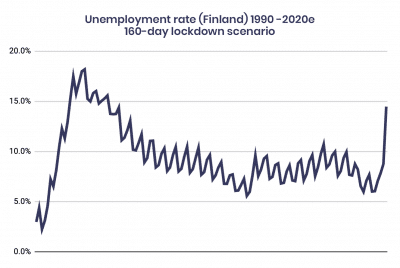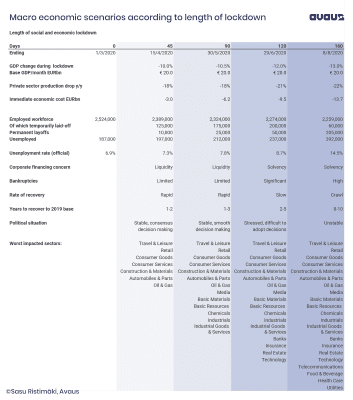Finnish companies have given notice of up to 150 000 redundancies by March 26th. In Sweden, the figures are substantially lower (25 000-30 000), which reflects their policy of only partial lockdowns and dubbed the “Swedish Experiment”. Across Europe, the coronavirus triggered downsizing, and operational shutdown of entire business sectors, beginning with hospitality and travel. These will come at a cost that we are only just beginning to understand.
In this blog, we will examine Finland, which has opted for a full lockdown and follow up on the Swedish case in a future post.
We think it is essential for CMOs and their CXO colleagues to have a proper understanding of how the macroeconomic situation might evolve, as we are struggling in the midst of the outbreak to maintain the health of our personnel, operations and financials. Macroeconomics is ultimately about us – companies primarily in the private sector with P&Ls, budgets and balance sheets that are now in the Covid-19 firing line.
Health Authorities in Finland estimate that it will take 120-160 days, starting from March 1st, before the outbreak is contained. The imposed economic and social restrictions all currently have deadlines that are far shorter than these estimates, but most will probably be extended. It is unclear whether this will be until zero, or very few, new Covid-19 cases are detected, or whether there is some other threshold for lifting the restrictions. Our analysis shows how economic distress and value loss grow with the length of the lockdown, with the damage becoming more severe and structural as the situation is prolonged.
In the present best-case scenario, the immediate economic cost of a lockdown that lasted until the end of May (90 days), would be around 6.2 BN€. This equals 2.5% of GDP. If the lockdown is extended to the end of August (160 days), the estimated immediate cost more than doubles, to some 13.7 BN€, representing 5,6% of GDP. The lockdown cost equals almost half a billion euros per week during the spring, growing to 600M€ per week if the lockdown persists over the summer holidays.
In addition to the direct costs, there will be further economic costs that will occur during the recovery. In the best-case scenario it will likely take us 1-3 years to recover economically back to the 2019 level, and in the 160-day scenario there will likely be substantial structural damage to our economy, leading to an 8-10 years recovery period.
Thus, the critical aspect of the economic impact will be the lockdown-induced permanent damage on the economy, due to unemployment, bankruptcies, lower consumer demand and foreign trade volumes and lower tax receipts.

Consequently, the economic reasons to alleviate or end the lockdown measures as soon as possible are significant. As we have two different response models in Finland and Sweden, this should ease the making of choices where health and economic concerns are not perceived as mutually exclusive. While we are fighting the epidemic, we also need to develop our awareness of the long-term consequences of a prolonged lockdown for our economy and the companies we work for.
The scenario calculation that follows below is not scientific. It is an illustration of how our situation may evolve depending on the length of the imposed lockdown. It is based on the currently available public information, financial analysis and experience of past economic crises, and is tied to benchmarks (e.g. China) where possible.
The 160-day scenario that totals a direct economic cost of almost 14 BN€, combined with a 8-10 year recovery period, would make the Covid-19 crisis comparable with the 1991-1993 downturn in Finland, which was also triggered by an external, unpredictable event – the collapse of the Soviet Union. That led to a loss of 20% of Finnish exports which compounded the structural problems that had been caused by the opening of Finnish capital markets in the late ‘80s.
It is likely that unemployment in the Covid-19 160-day scenario would spike to some 14-15% during the autumn, with development beyond that highly uncertain. Unemployment is a difficult indicator as in the statistics employees temporarily laid off are still counted as employed. In other words, official unemployment spikes only if, or when, temporary layoffs are made permanent. But, at that moment the situation becomes significantly worse, as returning those people to work may take years, not months.
In any case, the earlier the lockdown is lifted the more likely that adjustment measures are still ‘temporary’, thus leading to lower peak unemployment and a quicker recovery. In this respect, it is likely to be critical that, as Finland returns from summer holidays in August, there must be a sense of normalcy, otherwise the economic crisis risks becoming entrenched.
In the worst-case scenario, by September the private sector would experience the loss of a significant number of companies and many of those surviving would be fighting to retain solvency, not just the liquidity that is currently focused on. Economic recovery would be painfully slow, as private demand would be held back by an inability of consumers to consume, companies would not have the financial resources nor incentive to invest and the public sector would struggle with a dramatic fall in tax-income.
Economics may be secondary in comparison to life, but as Swedish industrialist, Jacob Wallenberg stated we need also to be aware of and to discuss the long-term consequences of the crisis. And echoing Mr Wallenberg, instead of a business versus life debate. we should take a life vs. life perspective. What else can we do, and how can we ensure recovery to a vibrant society?
The fight against the coronavirus outbreak is not only a fight for our lives, but it is also equally a fight for our livelihoods. This originated as an Avaus internal analysis, made to better understand the dramatically changing operating environment and the challenges ahead that we all have to face. We thought we should share our findings with our customers and stakeholders. Obviously we welcome the questioning of the key assumptions, especially since the conclusions related to a long term lockdown are so stark.
